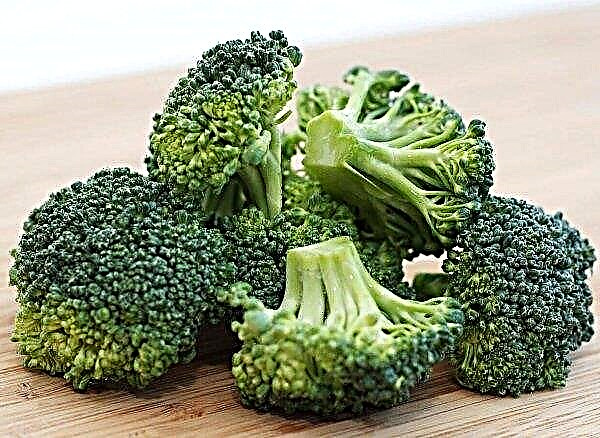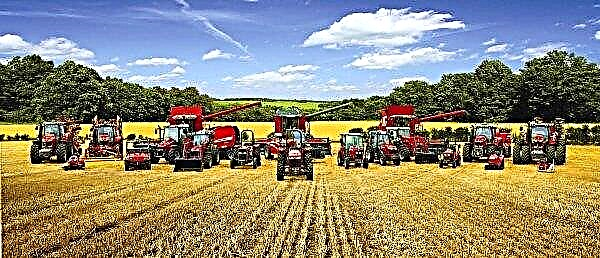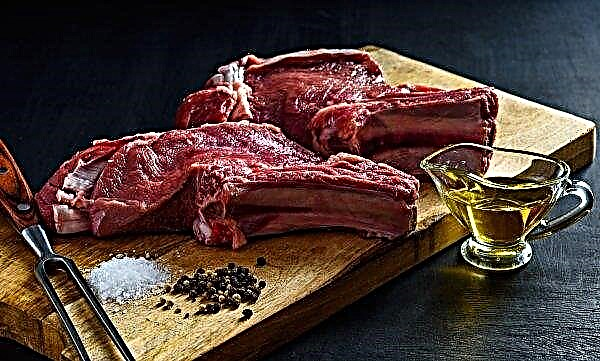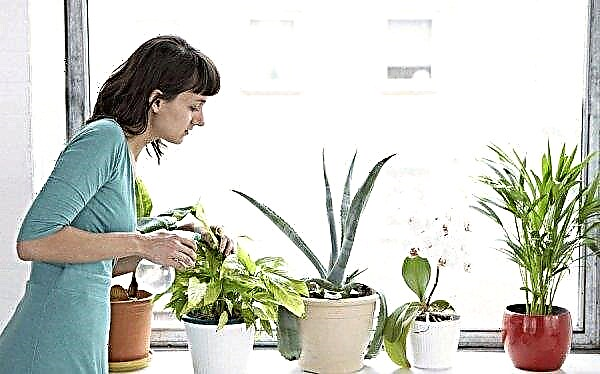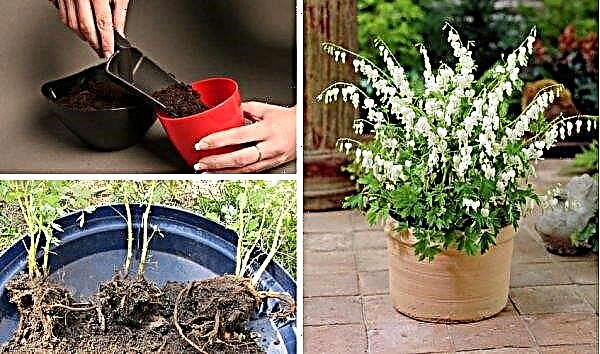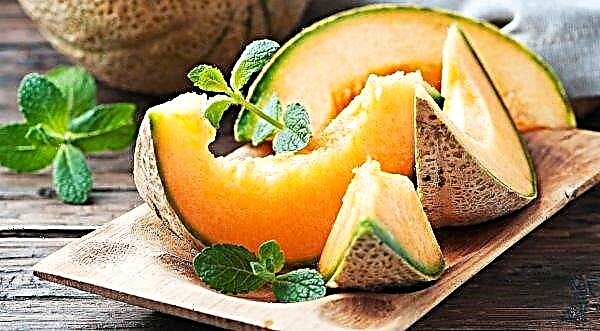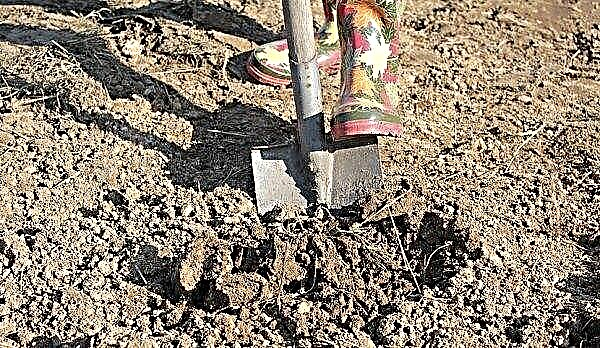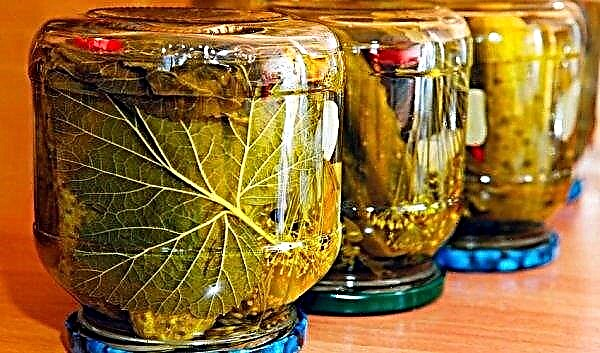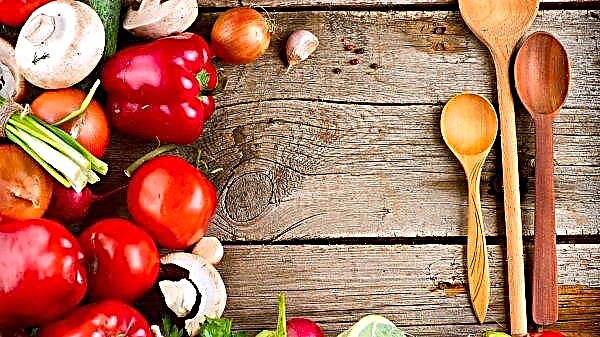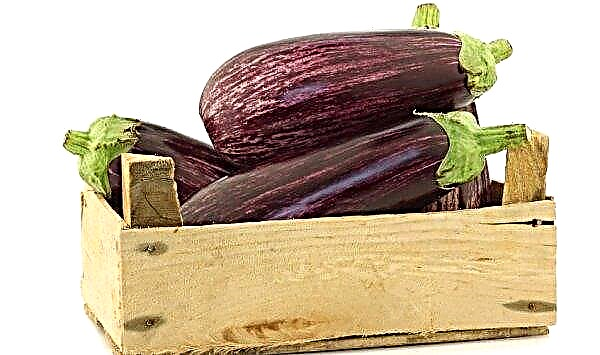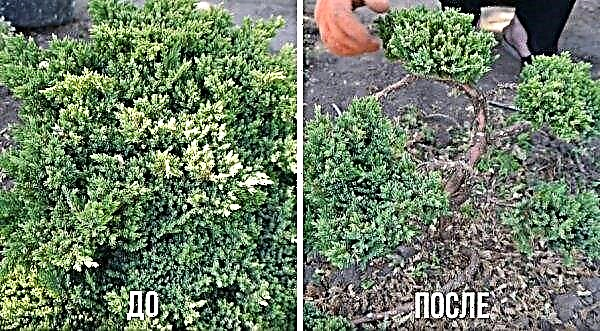Growing pepper in a greenhouse differs from growing a plant in open ground. The greenhouse has created ideal conditions for the rapid growth of bushes, but lush foliage absorbs all nutrients from the soil, which affects the size and taste characteristics of fruits, so the question arises of the need for pruning plants to reduce the number of leaves and shoots. Read more about whether to create pepper bushes in a greenhouse, the basic rules and techniques of this procedure, as well as step-by-step instructions on how to form plants - further in the article.
What is pepper formation for?
Beginner farmers often underestimate the importance of forming a bush of sweet pepper and do not pay enough attention to this procedure, cutting off only dried leaves and shoots.
Did you know? Eating bell pepper stimulates the formation of endorphins in the blood, which are called "hormones of happiness."
- The correct formation of pepper bushes helps to achieve these goals:
- removal of sterile shoots without ovaries, the cultivation of which the plant is wasting power;
- removal of excessive amounts of inflorescences and ovaries - helps to avoid overloading the plant;
- guarantee uniform ripening of the crop;
- improved breathability of foliage;
- free penetration of sunlight to all fruits and parts of the bush;
- good commodity characteristics of ripened fruits;
- reducing the risk of diseases and pests;
- neat appearance of plants.
What varieties need to be formed
There are many different varieties of pepper, differing from each other in the size of the bushes. And if the undersized varieties do not have too lush green mass, then the tall ones can reach a height of 2 m and have dense foliage.

The need for plant formation is determined depending on its height:
- undersized varieties having a height of up to 50 cm, can be grown without formation, provided that they were not planted too close to each other. If the plants are planted densely enough, then you need to cut off the extra shoots and leaves in order to improve air access to the roots and provide illumination of all ripening fruits;
- medium-sized varieties peppers grow to a height of about 1 m and need to trim the lower infertile shoots, which in vain pull the juices from the plant. It is also recommended to get rid of some leaves so that the thick green crown does not obscure the fruits from the light;
- tall varieties bell peppers grow up to 2 m and need to be formed. They need to be grown in 1-3 stems, timely performing removal of stepchildren, extra shoots and leaves, as well as stopping the growth of the main branches at the stage of ripening of the formed fruits.
When to form a bush
Peppers are usually grown in seedlings and then transplanted into the greenhouse. But you need to start plant formation before it is transplanted into the greenhouse. Usually, a seedling begins to branch after it reaches a height of 15–20 cm.
Important! When planting pepper seedlings in a greenhouse per 1 square. m area may be no more than 5–6 plants. At the same time, free space should remain around the seedlings to increase their volume by 2–3 branches.
At this stage, the first sprout formation is carried out. Further formation is carried out according to the rules described later in the article.
Basic rules for forming a bush
The formation of a bush of pepper is carried out gradually. It consists of several important steps and takes time. Let us consider in more detail the basic rules for the formation of plants.
- Removal of the crown bud. It is carried out at the stage of seedling growth, when the seedling stalk branches out into 2 separate powerful shoots. In this case, a bud is formed between these branches, which is called the crown. In order for the seedling to continue to grow and branch actively, the crown bud should not bloom, so it is removed. If it is planned to use seeds obtained independently for growing sweet pepper next year, then the crown bud is left on 1-2 plants, since the highest quality seeds for planting are formed in it.
- Trimming excess shoots. In the process of further growth, the main stem begins to branch. In the fork where the crown bud was removed, several new shoots are formed. Of these, 2-3 of the most powerful are selected, and the tops of the remaining shoots are cut off.
- Trimming lower leaves and barren shoots. Under the place of the first fork on the main stem, lateral shoots and leaves begin to grow. Such shoots are called barren and pruned. Too many leaves obscure the fruit and can slow their ripening, so they are also removed. It is equally important to prune damaged, dried and diseased leaves, as from them the infection can spread to the entire bush.
- Pinching the tops of the stems of the first order. It is carried out after about 15–20 fruits are formed on the branches. In this case, further growth of the main shoots will not increase the total amount of the crop, but will only take strength from the plant, therefore, pinch the tops of such shoots so that the formed fruits grow large, sweet and can ripen in time.
Did you know? Bell pepper is actively used in cosmetology for the manufacture of anti-aging face masks and hair care products.
Formation methods with step by step instructions
Under ideal conditions, polycarbonate greenhouses pepper bushes begin to grow actively. In order not to overload them with large green mass and at the same time not to cause them stress by excessive pruning, you need to form a bush correctly. Most often, peppers in a greenhouse are grown in 1, 2 or 3 stems. The method of formation depends on how many plants are located in the greenhouse.
In one stalk
This method of formation is used when plants are planted very close to each other and there is not enough space in the greenhouse to grow bulky bushes.

A step-by-step instruction for the formation of pepper in one stem is presented below:
- The formation of the bush begins at the stage when the main stem of the plant branches into several lateral shoots.
- Remove all lateral shoots that begin to form as a branch from the main stem. You should get a straight bush with one straight stem on which leaves and flower brushes grow.
- If in the process of plant growth, forks again form on the main stem, then they are carefully cut, leaving only a flower bud and 1-2 leaves above it.
- When 10-12 fruits are formed on the bush, you need to pinch the upper growth point on the stem. This will ensure the ripening of the formed fruits, and also stop the growth of the plant in height.
In two stems
This method of pepper formation is the most common and allows you to get a neat V-shaped plant, which houses at least 20 large fruits.

Consider a step-by-step instruction for the formation of pepper in two stems:
- Such formation should begin at the stage when the main stem of the plant branches into several lateral shoots.
- Trim all side stepsons extending from the main stem, except for the very first stepson. You should get a bush with two stems of the first order.
- When branches of several shoots begin to form on the shoots of the first order, leave one strongest and cut off the rest above the level of the first flower bud and one leaf.
- Repeat the steps from the previous paragraph for second, third order shoots and so on until about 20 ovaries form on the bush.
- Pinch the top of the two main shoots of the first order. This will help stop the growth of the plant in height and ensure the ripening of the resulting fruit.
In three stems
Pepper bushes, which are grown in three stems, take up a lot of space in the greenhouse, but give a larger crop of fruits that have good marketability.
Important! This method of forming a bush helps to achieve the best lighting for all peppers, as a result of which the crop ripens faster.
A step-by-step algorithm of actions when forming a pepper bush in three stems is described below:
- The formation of the bush begins at the moment when the main stem of the plant branches into several lateral shoots.
- If the main stem is immediately divided into 3-4 strong shoots, then only 3 branches leave, and pinch the extra shoots.
- If at the fork the stem branches only into 2 parts, then the formed branches of the first order do not cut and wait for the next strong shoot to emerge, departing from the main stem.
- After 3 main strong branches of the first order are selected, forks also begin to form on them. At each fork, only the strongest escape is left, and the rest are nipped. When trimming excess branches, only the first flower bud and a couple of leaves above it are left.
- Repeat the steps from the previous paragraph for third-order shoots and so on until about 25 fruits are formed on the bush.
- Pinch the top of the three main branches of the first order. This helps to stop the growth of the plant in height and ensure the ripening of the formed fruits.
Scheme of pepper formation in one, two and three stems:
Basic tricks
For the proper formation of a bush of pepper, three main methods are used: pinching, pruning leaves and pinching the stems. Each of these procedures must be carried out according to certain rules, which will be described later in the article.
For clarity, consider the structure of a bush of pepper grown in a greenhouse (see. Fig.):
 1 - the main stem of the bush; 2 - shoots of the first order; 3 - branches of the second order; 4 - skeletal shoots.
1 - the main stem of the bush; 2 - shoots of the first order; 3 - branches of the second order; 4 - skeletal shoots.
Black horizontal strokes indicate places for pinching the shoots. Consider the main methods of plant formation in more detail.
Stepson
This technique consists in the removal of stepsons - small lateral processes that are formed in the axils of the leaves in the process of growth and branching of the stem and shoots. They take away from the plant the strength that is needed to form a large number of large and beautiful fruits.
The main recommendations for pinching bushes of bell pepper are presented below:
- removal of stepsons should be carried out only after the plant reaches a height of 30 cm and its main branches are sufficiently strengthened;
- all small lateral shoots that appeared under the branching point on the main stem must be removed;
- when removing stepsons, it is recommended to leave stumps about 3 mm high so that the plant is not exposed to diseases or attack by pests;
- planting is carried out early in the morning, and after the procedure, the earth around the bush is loosened and watered;
- stepsons can be removed only with sharp and disinfected tools.
Topping
The key to a plentiful harvest is not only a large number of fruit ovaries, but also their timely and complete ripening. With uncontrolled growth of shoots, numerous ovaries can form, but they will only draw juices from the bush and will not be able to give a full crop. To avoid this, carry out the process of pinching the shoots.

The basic rules for pinching peppers are described below:
- when the main stem of a plant branches into several parts, they are pinched, leaving only 2-3 of the most developed stems that form the skeleton of a bush;
- when another branching of several shoots forms on the skeletal branches of a plant, only the most developed of them is left, and the rest are nipped;
- when further branches of several shoots are formed on second-order shoots, only the strongest of them should be left, and the rest cut off above the flower bud;
- after the formation of a sufficient number of fruit ovaries on the bush, the growth points on all the main shoots are pinched;
- the last pinching of the stems should be carried out no later than 1 month before the end of the fruiting of the bush.
Pruning
In order for the ovaries formed on the bush to turn into large fruits and ripen in time, they need to provide good access to light and air. To this end, they trim unnecessary leaves that overshadow the plants and take away excess nutrients from it.
Did you know? On the territory of Russia, bell pepper appeared in the XYI – XYII centuries. At that time, it was grown only as an ornamental plant.
This procedure must be performed according to the following rules:
- all dried and damaged leaves must be removed;
- pruning of green leaves should be carried out only on healthy bushes, since after this procedure the plants are more susceptible to diseases and attack of possible pests;
- leaves on the main stem can be removed after the peppers on the first order shoots have reached the stage of technical ripeness;
- no more than 2 sheets can be deleted per crop;
- when peppers of the second brush have reached technical ripeness, it is possible to break off the leaves located under it, and so on;
- when trimming excess leaves, it is necessary to ensure that over each ovary or fruit on the stem there are 1-2 leaves, since due to them the fruit is nourished;
- the last pruning of leaves is carried out 1.5 months before the full ripening of all fruits.
Video: How to shape peppers in a greenhouse
Follow-up care
So that at the end of the season the farmer has a good harvest of sweet pepper, in addition to proper formation, the bushes need to be provided with the necessary care.
The basic rules for pepper care in a greenhouse are listed below:
- watering as necessary, but at least 1 time in 5-7 days. Water for irrigation should be warm, about 2 liters are consumed per plant;
- ventilating the greenhouse to reduce humidity and prevent condensation;
- fertilizing plants with mineral fertilizer complexes after transplanting seedlings, before flowering and at the stage of fruit formation;
- loosening the topsoil around the bushes to improve air permeability;
- plant protection from direct sunlight in hot weather (above + 30 ° C);
- tying side shoots to established supports for plant balance.
Important! In hot weather, pepper bushes should be watered at least 2 times a week.
Useful Tips
If you adhere to all the rules for forming a bush described above, you can get a plentiful harvest of pepper, which has high commercial qualities.
But so that pruning and pinching the shoots does not harm the plant, you need to follow a few more recommendations:
- Only healthy plants can be formed; diseased bushes can die as a result of this procedure.
- Cutting of all shoots and leaves is carried out with sharp tools, disinfected in a solution of any antiseptic.
- It is impossible to carry out the formation of pepper bushes in the greenhouse during extreme heat - a lush green mass helps protect the stem from burnout.
- The pruning and pinching procedure is best done early in the morning when there is no scorching sunlight.
- You can not form plants that have not reached a height of 20 cm, since pruning can lead to the death of a young plant.
- If the pepper bushes in the greenhouse are planted very far from each other and do not touch the leaves, then the green mass is not trimmed.

The procedure for the formation of pepper bushes requires the farmer time, patience and some effort.But if you perform pruning and pinching, taking into account all the recommendations described, then at the end of the season the plants will surely please you with an excellent crop of delicious and beautiful peppers.


